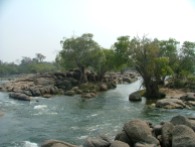Propeller cage repaired, we headed back out on the water the next morning with fishing gear in tow. Steve is the fishing guy, and proceeded to catch something on his first cast. I was content to hang out on the rocks, take pictures and look at birds.
As the only guests at the lodge, we had the luxury of deciding what we wanted to do, and when we wanted to do it. Kaingu has a hide, so we said that we’d like to spend the afternoon hanging out at the hide. Boyd walked us out there – about a 10 minute walk – with our journals, cameras and binoculars. We did spot lion tracks along the way, but not the lions themselves, while we were walking. This hide was just a reed structure with benches, and a shelf for resting elbows and binocs. Rather than up on a platform, the entrance is at an angle to create a slight baffle.
We been out there for maybe an hour or so, when we heard a lion…or something large…grunt. We looked as far we could around the viewing “window” of the hide, and Steve peered around the edge of the opening of the hide. We knew that Boyd would be back for us, but I tucked myself further into the hide, and we stayed alert. The most we saw all afternoon were impala, puku and warthog, but we could very well have had other visitors near by.
For sundowner, we headed out to The Big Rock not far from camp. Egbert first stopped by a project he had worked on the previous year, creating an interpretive center for the iron foundry site near the camp. In John Reader’s Africa: A Biography of the Continent, he outlines the evidence of iron smelting in northern Africa at least 3,000-4,000 years ago. This technology probably moved south with the Bantu-speaking people, and there is evidence that the ancient methods were still being used in the Kafue area as recently as a few hundred years ago. The process included charcoal-making and kiln building and venting – quite a laborious and complicated process. And, the knowledge of the process was tightly protected within families, creating a kind of iron-smelting cartel. Clearly, the technology and the iron produced were valuable.
As sundown approached, we headed to the top of the rock, used locally by the native residents for ceremonies and celebrations. We watched the sun sink into the smoke from bush fires further west, while we asked about the persistent smoky pall we were experiencing on this trip – actual blue skies had been rare. As the sun set, we watched the glow of the fires as they flared – at one point we could actually see flames.
The resident mice came out with the moon rise – clearly accustomed to “leftovers” from sundowners on the rock. We headed back to the camp for yet another fabulous meal. Steve completely flustered Elizabeth when she came out to announce the menu, telling her, “I luuh-ve you,” expressing his appreciation for the caramel dessert the night before. Zambians are far more reserved, but they took the American-style joshing and joking in stride. We had a merry fireside dinner with Egbert, and great conversation about life in the Kaingu area.










